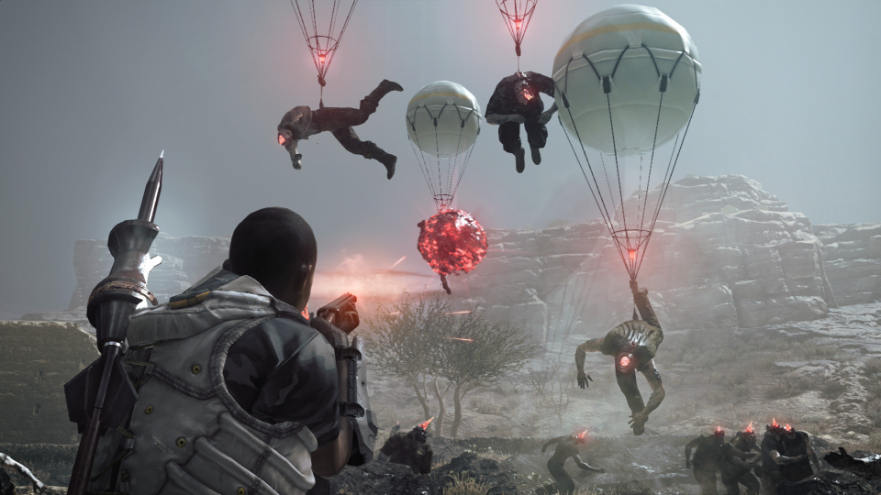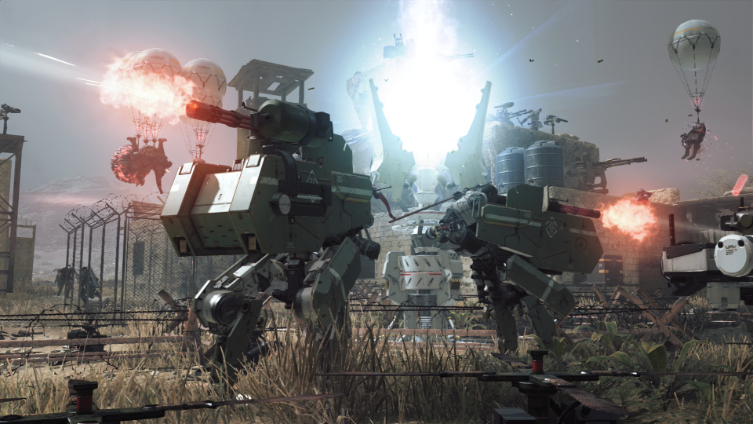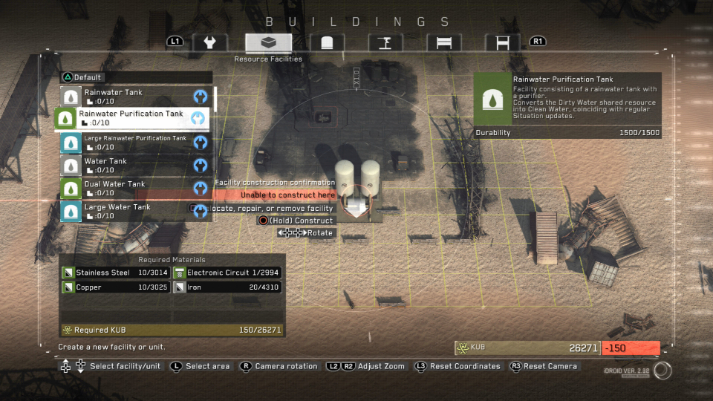Metal Gear Survive is a new spin-off title from the Metal Gear franchise, focusing heavily on base defence, simulation and FPS action. Moving away from the previous Solid series, Survive puts you in the shoes of a more everyday guard from Big Boss’ faction on Mother Base, instead of the normal boots of clones or cyborg ninjas. With a horrendous amount of stigma and bad-blood thrown in the direction of Konami over recent events and the dire shift in genre, Metal Gear Survive will seemingly need to live up to its name and survive in the game market.
The story starts off with a rather haphazard intro, moving us between action scenes and slightly “before and after” shots of what is going on. Showing events from the attack on mother base at the end of MGS5 Ground Zeroes, we are introduced to our almost silent protagonist, a soldier in Big Boss’ army who was killed, or at least severely wounded, during the attack. The major damage was done by a wormhole opening in the skies above, pulling all kinds of matter into it, along with cutting off our protagonist’s arm as they tried to pull someone out of it as it closed.
Some reanimation later, our character has revived and been sent back through a wormhole to bring back our men and women from the other side, Dite, a world parallel to ours. On the orders of Goodluck, we investigate the other side of this wormhole, a new dimension inhabited by dust that takes over matter, both living and material. Dispatching wanderers, humans who were killed and taken over by the dust, we search for the previous expedition sent here alongside any other survivors.

The main story takes some twists and turns that is common to the MG series, sticking true to most of the formula and actually being able to pull off some of its events surprisingly well. Playing through the main story will run you around 15 hours depending on how well you play and the amount of side-content you go through. My first run took me around 21 hours, some spent doing online as well as side missions and such. After the story ends you are put into post-game, where you have 3 or so more missions to complete and are allowed to free-roam with random missions popping up here or there for more rescued survivors or optional bosses.
Your basic soldier has 4 stats, Strength, Vitality, Dexterity and Endurance, increasing the damage with melee weapons, max life, movement and readying speed, and max stamina respectively. These start at 10 points each, increasing by 5 for every skill point you spend, with a max of 5 skill points allowed per stat. Life and stamina started at 3000 for base stat level. As you complete online matches, loot wanderers in story mode or gather Kuban Crystals you would gain Kuban Energy that could be used to level up your current class, with Survivor being the base class, which in turn gave you skill points. These skill points could be spent to increase your base stats, unlock new moves with certain weapon types or abilities like leg sweeps or faster pickup speed.

In the post-game, you can unlock 4 more sub-classes that allow you to focus more on 1 aspect of combat or movement. Assault is for close-quarters combat, Jaeger for shooting, Medic to heal your party and Scout for sneaking and stealth attacks. You can also spend more points in the 4 base stats, though you can only equip 1 class skill and 3 additional abilities like stealth kill combos until you reach level 20 in a subclass when you unlock a 4th ability slot.
Just like in MGS5 you can equip your soldier with a plethora of weapons and items. Primary weapons for your melee weapons, bow, spear and larger guns, with secondary weapons for your smaller pistols and shotguns. You could have 2 primary weapons and 2 secondary weapons, alongside 4 gadgets, like Molotovs and first aid kits. Besides your arsenal of weapons and gear, you can also change your clothing, gaining higher defence against damage, as well as add-ons for more ammo packs on your person. Finally, you have survival equipment, from more quivers to a small bag that allows you to carry more items in combat or even equipment slots for more weapons and gadgets.
Controls in Survive felt very, and I mean very, weird at first, becoming almost too complex and jam-packed. You could aim with L2 for your weapon, L1 for your thrown weapon on the left, or R1 for the right with R2 being your shoot or slash button. You would change between primary weapons with the up directional button, with secondary’s being swapped with the down directional button, though they took up the same slot so only 1 could be used at a time. Circle allowed you to crouch or go prone, double tapping x for a dodge, square for interactions and sprinting by clicking in the left Thumbstick.

Thankfully the control system becomes very fluid and second nature after a few hours, I even found them very tight with no real problems. Getting into matches was rather easy as well, simply select a map to play solo or go into matchmaking. I found no issue staying in a match, nor did it take long to find a group. The game kept me within European servers and players, and I generally had a good experience with connectivity.
Just like in the Beta, Survive really throws you into the thick of it, you start off the game with no weapons or gear and with 50% hunger and thirst meter. Learning by being put into the deep end of the pool, you are taught about crafting weapons from scavenged materials, cooking native plants and animals as well as how to build a base. The way it is set up feels fluid if a bit forced and hand-holdy. A major issue is the AI attached to you, always reminding you about food, water and stamina.
Like in previous games, you can crouch up behind enemies to stealth kill them with R2. The way that Survive is designed, however, leans more in the direction of quick movement and simply attacking them straight up. If you are able to do stealth take-downs you can then collect the corpses with the wormhole extraction device for more Kuban energy, or even knocking out wildlife to store in cages back at base.

Co-Op is set up in levels, ranging in difficulty from easy to hard, alongside daily levels. The main aim is getting to the defence area and setting up defences to survive against 3 waves of wanderers and other infected enemies. You can go to local workbenches to craft fences, turrets and sandbags, or create ammo for your weapons. The materials you pick up in the level are shared between the 4 members of your team, so everyone will need to work together to make something worthwhile. After you have crafted defences you can select them with left or right and plant them around the area by holding R1 and pressing X.
Each co-op wave ended with a pulse from the machine that was digging for Iris energy, destroying defences that are within the red ring it displays. You need to rebuild your structures or build far enough away so that the end burst would not get your units. This repeat of phases allows players to mess around with new forms and tactics for the maps, refreshing any badly placed structures. You are given 3 minutes to prepare for the next wave, even giving you some side-missions on the map to gather refills of ammo or walkers to help out.
Iris energy was farmed through each wave and is Survives form of point system for the match. The higher your points, the better your ranking, with 100,000 points being an A rank or 200,000 points being an S rank. These ranks would determine the quality and quantity of loot gained at the end of a match, with a box given for ranks D through S giving 1 box, with a total of 5 boxes per match. Resources farmed during a match were shared, including Kuban energy, but these winning resources were personal to you, being saved to your survivor for use in single player. Resources in single player allow you to bring in defences to a match or improve your gear beforehand, but the single player resources themselves would not come into a match with you.

The music in the Survive is very ambient, taking a back seat to your traversal and stealth. It has a very dark tone to it, with a sense of dread and sorrow, fitting to the environments and events. When battle kicks in, so does the energy of their music. The soundtrack does seem a bit small, though it does contain plenty of music from previous games, outside bands and more through finding hidden boxes in single player that can be played at your base or in the co-op lobby.
Co-op is seemingly gated to your level, at level 1 I was doing around 10 damage to the infected who were level 20, but at higher levels that became closer to 100-200. Higher level play did make the matches easier, from both your personal stats and that of your equipment. You also unlocked new defences through the end-match loot, like turrets and traps, allowing for further customisation of your defence. At times I just tested out the emergency help from the digger, like interceptor units and walker gear, though even now I cannot seem to find the Metal Gear Ray of the beta.
Overall, Metal Gear Survive gets an 8/10, I had a blast with the gameplay, offering plenty of side-missions to do, approach to your loadout and missions. The story is rather good, with well-made plot hooks and twists, though felt a bit rushed at times combined with its rather short lifespan of 15 hours. Co-op gameplay is fluid and engaging, with rewards given to those who plan properly or pay attention to the ongoing events. The controls did feel weird in the beginning, but can be learnt rather easily, with higher level play requiring some good positioning and tactics. I found little to no bugs, with the difficulty curve feeling on point for the majority of my play time

Sadly, following on from their harsh practice with micro-transactions in MGS5, Survive continues such with requiring you to pay for more save/character slots and exploration teams in single-player. They are way too expensive with no way to accrue their SV coins in-game besides the daily login bonuses. Just like in MGS5 with their FOBs, Survive gates your progression in such a stupid way that it feels like just a cash grab for those who “want it faster”.
Survive is a much better game when you view it as just what it is meant to be, a spinoff title. Just like Rising was with its cyborg ninja action game, Survive is just a defence game based on the Metal Gear lore and world. Plenty of companies have done similar, like Square Enix with their Tactics spin-off from Final Fantasy to Atlus with their dancing rhythm titles or Arena fighting games from their Persona series.








You must be logged in to post a comment.